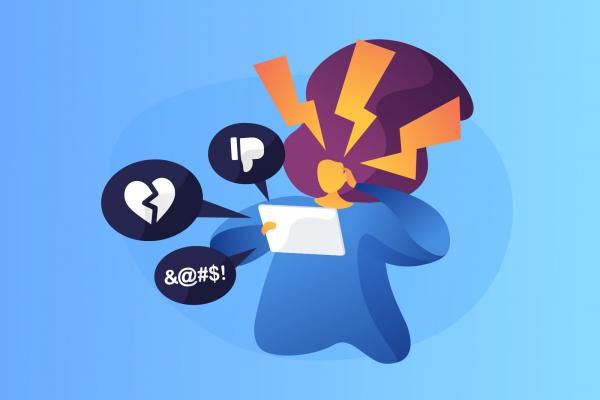Cyberbullying Since COVID-19
- nestmeagle
- Mar 7, 2021
- 4 min read
Updated: Mar 17, 2021
By Shrina Dong '24 and Amila Shah '23

Visual: Unicef
The COVID-19 outbreak has deprived teenagers of in-person social interaction. As a result of this deprivation, a massive number of teenagers have found solace in social media, like TikTok and Instagram. While social media can be a positive outlet for people to connect online, there is a flip side: cyberbullying. Social media has solidified its standing as a place of “cancel culture,” constant hate, and negativity.
It is expected for kids and teens to spend more of their leisure time on their devices during recreational hours, even when there isn’t a pandemic. We, as well as many NEST+m students, have experienced significant spikes in the recorded screen times on our phones. The only contact with peers is virtually, and parents usually don’t monitor what’s going on behind their child’s phone, making the problem more unknown. With both a screen to hide behind and the lack of parental intervention, teenagers are held less responsible for their actions. Thus, teens have experienced a spike in cyberbullying. According to L1ght, an organization that monitors online harassment, “There has been a 70% increase in cyberbullying in just a matter of months…”
One area of social media where cyberbullying prevails is in Instagram DMs. Instagram users can unfairly become targets of harassment by making a joke with absolutely no harmful words or intentions or pointing out the hypocrisy in the comments of a post. Seeing hate speech targeted towards them can make these individuals feel uncomfortable and lost. The problem with DMs is that accounts can continuously attempt to message an account, even if the person they are trying to message does not follow or accept their messages. This gives bullies the opportunity to send several unsettling words on multiple accounts, and it may take hours of googling to learn how to deal with the situation since victims may be new to it. (You have to block, restrict, and turn off message requests in your Instagram settings.) Moreover, the guidelines of social media apps, such as Instagram, pose difficult situations for victims. Under Instagram’s community guidelines include, ‘Hate Speech, Bullying and Abuse - We remove credible threats of violence, hate speech and the targeting of private individuals.” However, hours after reporting, many people find themselves looking at a screen that states, “We found that this message/post/user did not violate our community guidelines.” They aim to create an open and safe environment for everyone, but what are the regulations on acts of harassment? What is and isn’t considered as cyberbullying on Instagram?
In a poll conducted on one of our Instagram stories, we asked if peers and friends had noticed that cyberbullying and online harassment had become more prevalent during the pandemic. Out of 63 people who responded, 28 (44%) said yes. Some were comfortable enough to share their experience. One poll responder shared her experience being harassed online by her own friends. She said, “Once I was talking in a group chat and then a whole bunch of girls started ganging up on me saying how I was a h*e and other nasty stuff.” However, many times, the online bully can be a complete stranger. “The anonymity online can boost one's confidence to be extremely rude because they believe they’ll be safe hiding behind a screen,” another poll responder described.
Being harassed online can make someone feel uncomfortable, scared for their safety, and stressed. What can we do to calm ourselves down?
Know that none of it is your fault. No one deserves to be treated cruelly, no matter the situation.
Don’t respond. In most cases, bullies and trolls online are just looking for a response. Don’t give them what they’re looking for.
Save the evidence. Take screenshots, just in case things escalate.
Reach out for help. If the behavior is getting to you and disturbing your daily routine, see if someone, like a close friend or a guidance counselor, can listen to you.
Most importantly, if you see someone being cyber-bullied, take action. Listen and help!
Here are some sources that may help you with combating cyberbullying, reaching out for help, understanding how to preemptively prevent cyberbullying, or just learning about what cyberbullying is overall:
https://www.stopbullying.gov/cyberbullying/prevention: This is a great resource where you can learn about how to be an upstander and prevent cyberbullying. This also provides help for how to deal with haters and how to better educate yourself about what cyberbullying truly is.
https://cyberbullying.org/teens-talk-works-stop-cyberbullying: The Cyberbullying Research Center is helpful if you want to gain an understanding about cyberbullying and its detrimental impact. It also provides tools for reporting cyberbullying and attaining help when you’re being cyber-bullied. Lastly, they also provide tips on how to preemptively prevent cyberbullying.
https://www.stompoutbullying.org: Stomp Out Bullying is a great organization, and their website is helpful for understanding what cyberbullying is, as well as how to combat it. It provides opportunities for getting involved, resources for reaching out, and understanding the most beneficial ways of handling cyberbullying, as well as providing a lot of information to educate you on cyberbullying as a whole.




Comments